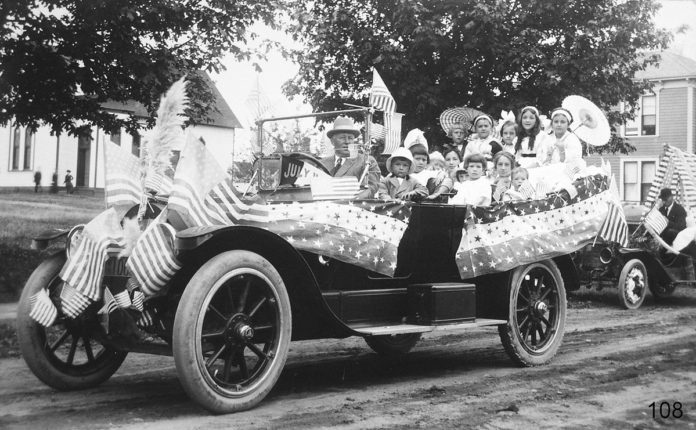Charles S. Hanson drives a 1913 Cadillac decked out for an Enumclaw Fourth of July parade, in the mid-1910s. Others identified are Robert Olson (directly behind the driver), Katherine Taylor, Margaret Taylor, Helen Hanson (with umbrella), and Clair Manning. This image #108 comes courtesy of the Carl M. and Anna (Gustafson) Hanson family and is now part of the Enumclaw Plateau Historical Museum collection.
Charles Hanson and his family of Swedish immigrants are certainly the most consequential force driving Enumclaw’s growth after a dark economic period in the 1890s. As a boy, Charles Hanson emigrated from Sweden to the U.S. in 1883 with his brother, Axel, and father, Carl M. Hanson. Charles learned English while living with an aunt in Northampton, Massachusetts, then followed his father to Washington, where Carl had filed a homestead claim for 160 acres on Lake Sawyer, then built his family a small log cabin.
Carl Hanson grew up in Sweden where he ran a small sawmill to supplement his income as a farmer. After immigrating to America, he made his way west with stops in Minnesota and Alberta, ending up near Black Diamond where coal mining was booming. Carl, with sons Axel and Charles, undertook a contract to build a portion of the railroad to Black Diamond. Carl’s first American sawmill followed at Eddyville on that same Columbia & Puget Sound Railroad near present-day Four Corner in Maple Valley. In 1893, Carl and his three sons built a larger sawmill on Lake Wilderness. Frank Hanson took charge of the mill, Charles looked after the mechanical end, and Axel was the business head. Carl’s future business partner and son-in-law, Louie Olson, was in nearby Franklin cutting timber and wood props for those coal mines.
The panics of 1893 and 1896 produced two acute, but short-lived economic depressions in the United States. Both came amidst a drop in gold reserves causing deflation in commodity prices and stock markets fell to new lows. In 1896, William Jennings Bryan unsuccessfully ran for president on a platform of “free silver” to increase money stocks and inflate the American economy. In Enumclaw, hop prices fell so low that it barely paid farmers to pick them. Then on July 29, 1896, the White River mill property was destroyed by fire. That disaster spelled the end of the White River Lumber and Shingle Company, which fell into bankruptcy as many employees were thrown out of work. Enumclaw homes went vacant as many residents departed for other jobs.
A week later, the fourth annual Farmer’s Picnic was held, but rain spoiled both outdoor sporting events and the literary program, as the picnic retired indoors to Jones’ Hall. In mid-December, 1896, when the Enumclaw area’s prospects looked bleakest, Carl M. Hanson, and his three sons, Axel, Charles, and Frank, with Louis Olson and Axel G. Turnbull, organized the White River Lumber Company to purchase from bankruptcy the old mill’s remaining assets. Their investments were a boon for Enumclaw, providing a key industrial footprint to supplement farming and dairy, leading to a town that has inspired loyalty in successive generations of residents and a welcome mat for new ones.
While most logging outfits experienced high turnover, many White River men worked their entire lives at the company. In the industry, White River Lumber had a reputation as a “Swede company.” Swedish men who came looking for work usually found it with the Hansons. It was great for those who’d recently immigrated to America, working with fellow countrymen who spoke their language and helped these newcomers learn the customs and language of their new home. In 1949, the Hanson family’s White River Lumber Company merged with Weyerhaeuser, which continued operations until 2002, then laid off the remaining 145 employees.







